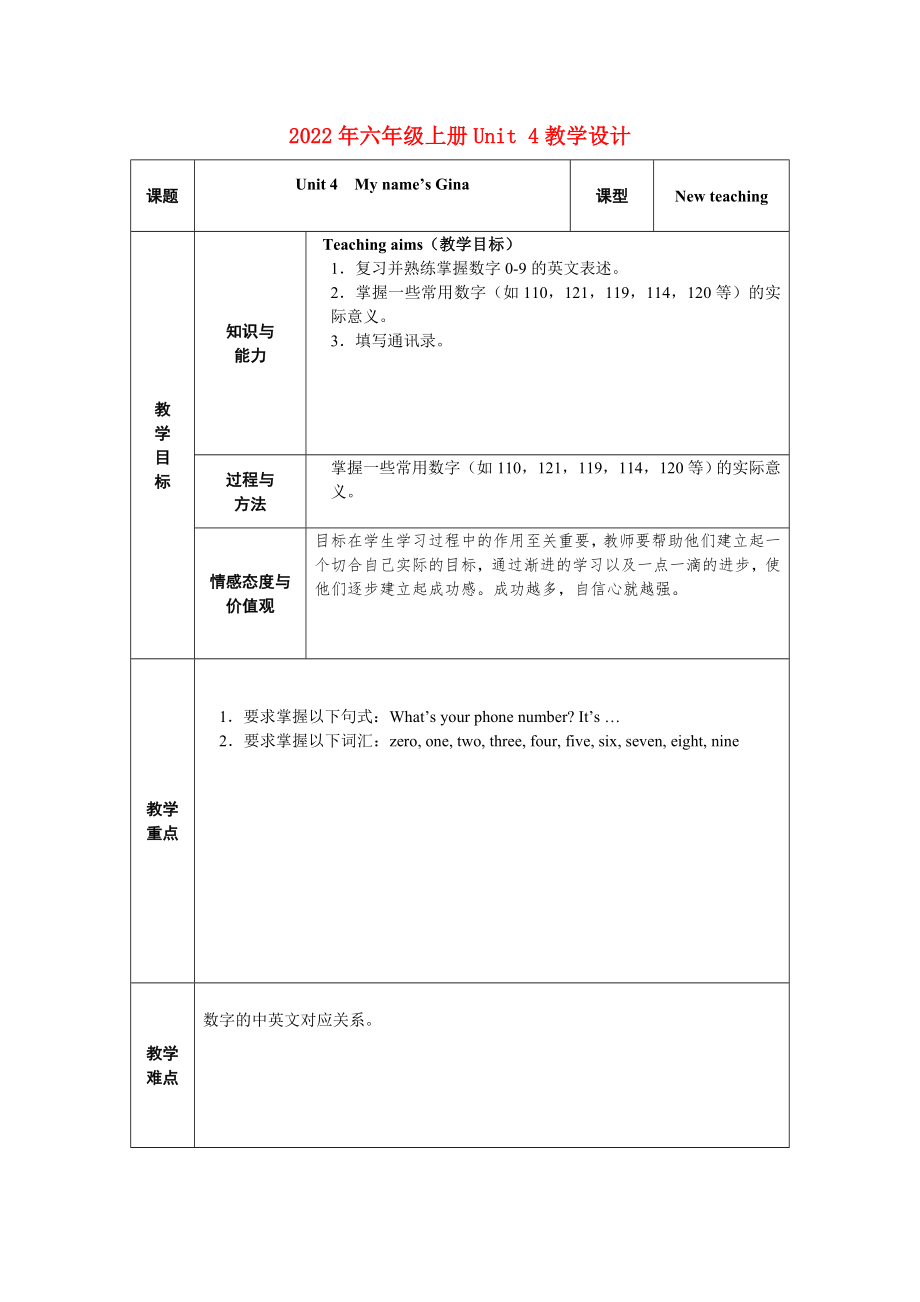《2022年六年級(jí)上冊(cè)Unit 4教學(xué)設(shè)計(jì)》由會(huì)員分享,可在線(xiàn)閱讀����,更多相關(guān)《2022年六年級(jí)上冊(cè)Unit 4教學(xué)設(shè)計(jì)(3頁(yè)珍藏版)》請(qǐng)?jiān)谘b配圖網(wǎng)上搜索。
1�����、2022年六年級(jí)上冊(cè)Unit 4教學(xué)設(shè)計(jì)
課題
Unit 4 My name’s Gina
課型
New teaching
教
學(xué)
目
標(biāo)
知識(shí)與
能力
Teaching aims(教學(xué)目標(biāo))
1.復(fù)習(xí)并熟練掌握數(shù)字0-9的英文表述���。
2.掌握一些常用數(shù)字(如110,121�,119,114�,120等)的實(shí)際意義。
3.填寫(xiě)通訊錄���。
過(guò)程與
方法
掌握一些常用數(shù)字(如110����,121,119�����,114�,120等)的實(shí)際意義。
情感態(tài)度與價(jià)值觀
目標(biāo)在學(xué)生學(xué)習(xí)過(guò)程中的作用至關(guān)重要��,教師要幫助他們建立起一個(gè)切合自己實(shí)際的目標(biāo)����,通過(guò)漸進(jìn)的學(xué)習(xí)以及一
2、點(diǎn)一滴的進(jìn)步����,使他們逐步建立起成功感。成功越多����,自信心就越強(qiáng)。
教學(xué)
重點(diǎn)
1.要求掌握以下句式:What’s your phone number? It’s …
2.要求掌握以下詞匯:zero, one, two, three, four, five, six, seven, eight, nine
教學(xué)
難點(diǎn)
數(shù)字的中英文對(duì)應(yīng)關(guān)系�。
教學(xué)
方法
如:遮蓋物品、顯露局部�����、辨認(rèn)物體、完形識(shí)別�、圖形辨認(rèn)等方法。
教學(xué)
用具
Tape-recorder��,multi-medium
板
書(shū)
設(shè)
計(jì)
T: P
3���、lease tell me how to say it in English? (show the Ss the number cards, one by one)4
Ss: It’s one.
Ss: It’s two.
教 學(xué) 過(guò) 程
教師活動(dòng)
學(xué)生活動(dòng)
1. Warming-up and revision(課堂熱身和復(fù)習(xí))
(1)Daily greetings to the students(日常問(wèn)候)
T: Good morning, everyone. My name is Peter.
What’s your name, please? 1
4�、S1: My name is Lily.
T: Hello, Lily. Nice to meet you.
S1: Nice to meet you, too.
T: And what’s your name?
S2: My name is…
(2)Revision(復(fù)習(xí))
Part one:
T: S1, what's his name? 2
S1: His name is …
T: S2, what’s her name?
S2: Her name is …
Part two:
S1: Good morning. What’s your name, ple
5���、ase? 3
S2: My name is Jack. What’s your name, please?
S1: My name is Susan. And what’s your name, please?
S3: My name is Tony.
S1: S4, what’ his name? (point to S2 )
S4: His name is …
1. 操練這個(gè)問(wèn)題是為了熟悉日常用語(yǔ)及對(duì)姓名的提問(wèn)法����; 同時(shí)也是為了使同學(xué)們盡快熟悉各自的英文名字����。 應(yīng)盡可能讓多個(gè)Ss作答。鼓勵(lì)他們大膽開(kāi)口�,大膽回答�。
2.重點(diǎn)復(fù)習(xí)、操練���、鞏固his, her, my, your這幾個(gè)物主代詞的用法及英文名字的使用�。
3.以小組為單位,同學(xué)間進(jìn)行交流�����, 既加大了句型的復(fù)習(xí)密度���, 同時(shí)促進(jìn)了相互之間的英文名字的了解與熟悉��。
2.
教
學(xué)
反
思
Oral work: (1) Listen to Section B 2a, read and recite it.
(2) Go on making up your dialogues with your partner and polish it.
 2022年六年級(jí)上冊(cè)Unit 4教學(xué)設(shè)計(jì)
2022年六年級(jí)上冊(cè)Unit 4教學(xué)設(shè)計(jì)

